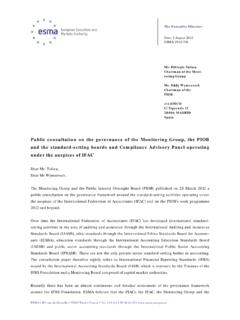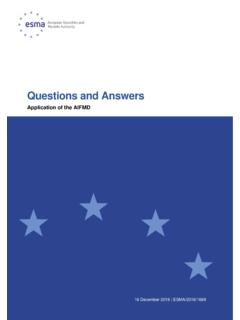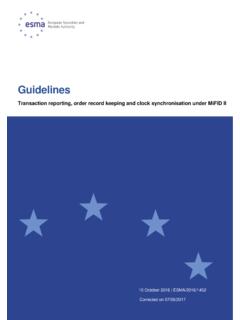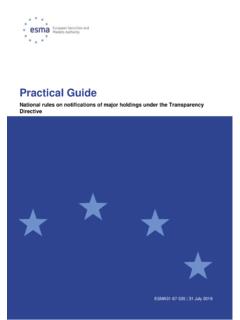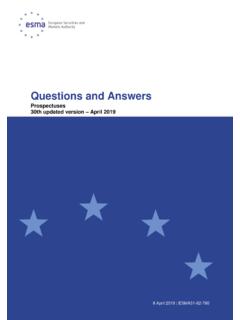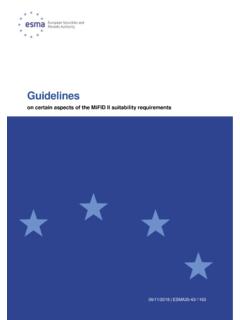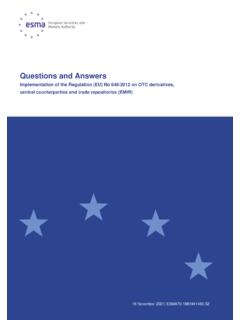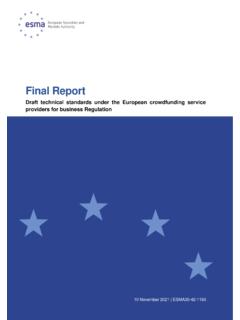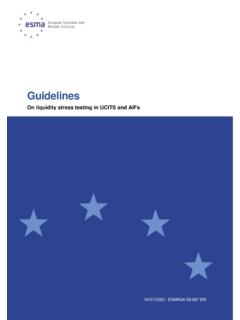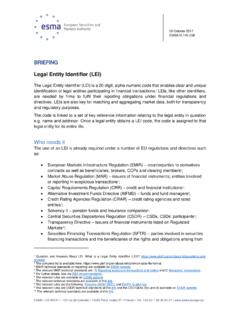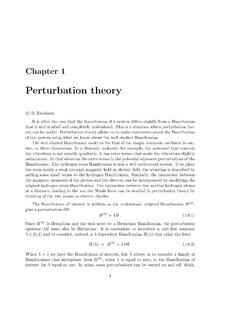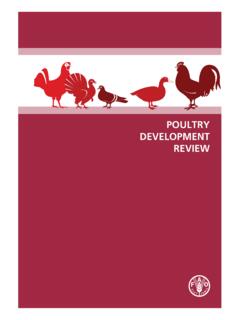Transcription of Guidelines - Europa
1 | ESMA/2014/869EN Guidelines Guidelines on reporting obligations under Articles 3(3)(d) and 24(1), (2) and (4) of the AIFMD ESMA CS 60747 103 rue de Grenelle 75345 Paris Cedex 07 France Tel. +33 (0) 1 58 36 43 21 Table of Contents I. Scope _____ 3 II. Definitions _____ 3 III. Purpose _____ 4 IV. Compliance and reporting obligations _____ 5 V. Reporting periods _____ 5 VI. Transitional arrangements (Article 61 of the AIFMD) _____ 5 VII. Procedure for first reporting _____ 6 VIII. Procedures when the AIFM of an AIF changes or an AIF is liquidated _____ 6 IX. Procedures when AIFMs are subject to new reporting obligations _____ 6 X. Reporting of specific types of AIF _____ 9 XI. AIFM data reporting under Article 3(3)(d) and 24(1) _____ 9 XII.
2 AIF data reporting under Articles 3(3)(d) and 24(1) _____ 12 XIII. AIF data reporting under Article 24(2) _____ 22 XIV. Information under Article 24(4) _____ 31 Date: ESMA/2014/869EN I. Scope Who? 1. These Guidelines apply to competent authorities. What? 2. These Guidelines apply in relation to Article 3(3)(d) and Article 24(1), (2) and (4) of Directive 2011/61/EU (the AIFMD) and Article 110 of Regulation 231/2013 (the Regulation) implementing the AIFMD. When? 3. These Guidelines apply from 2 months after publication of translations. II. Definitions Interim Entity Identifier The interim code used to identify counterparties defined in Article 3 of Commission Regulation 1247/2012.
3 Legal Entity Identifier The identifier referred to in the Financial Stability Board s (FSB) rec-ommendations on A Global Legal Entity Identifier for Financial Mar-kets . Acquisition Capital Capital provided to operating companies intended for growth via acquisitions. This capital is normally provided for a specific, identified acquisition target. Buyouts The practice whereby a private equity firm typically acquires a majority stake (if not 100%) in an operating company and retains a control position. Consolidation The practice whereby private equity firms acquire multiple companies to consolidate into a larger entity. Corporate Divestitures Investment in a non-core division of a larger corporate entity.
4 In this case, the corporation is spinning off a division to a private equity firm. ESOP Employee Stock Ownership Plans are mechanisms to transfer corpo-rate ownership to its employees in whole or in part. Private equity firms sometimes contribute equity capital to finance this ownership transfer. Growth Capital The equity investment by a private equity firm specifically to facilitate specific growth initiatives. Recapitalisation A strategic change in a company s capital structure usually involving a partial transfer of ownership. A recapitalization often occurs when an 3 owner wishes to cash out of a partial interest in the business (the proverbial take some chips off the table ).
5 In this case, a private equity firm would provide the equity to pay the owner in exchange for a per-centage of ownership. Shareholder Liquidity Similar to a recapitalisation, in that it involves a strategic change in capital structure, but usually with a different intent. With this strategy, a private equity firm provides the company with enough equity to completely cash out an owner, typically for family succession plan-ning purposes. Turnarounds Private equity firms may provide equity with the intent of turning a distressed or special situation company into a financially stable com-pany. Often, distressed or special situation companies are in default ( bankruptcy) or close to it.
6 Value of Instruments Unless otherwise specified, this means valuation of instruments in accordance with Articles 2 and 10 of the Regulation. Aggregated Value Means the aggregated value of instruments without netting. Net Asset Value The net value of the assets of the AIF (as opposed to the Net Asset Value per unit or share of the AIF). Net Equity Delta The portfolio s sensitivity to movements in equity prices. CS 01 The portfolio s sensitivity to a change in credit spreads. DV 01 The portfolio s sensitivity to a change in the yield curve. III. Purpose 4. The purpose of these Guidelines is to ensure common, uniform and consistent application of the re-porting obligations to national competent authorities (NCAs) stemming from Articles 3(3)(d) and 24(1), (2) and (4) of the AIFMD and Article 110 of the Regulation.
7 These Guidelines achieve this goal by providing clarifications on the information that alternative investment fund managers (AIFMs) must report to NCAs, the timing of such reporting together with the procedures to be followed when AIFMs move from one reporting obligation to another. 4 IV. Compliance and reporting obligations Status of the Guidelines 5. This document contains Guidelines issued under Article 16 of the ESMA Regulation1. In accordance with Article 16(3) of the ESMA Regulation competent authorities must make every effort to comply with the Guidelines . 6. Competent authorities to whom the Guidelines apply should comply by incorporating them into their supervisory practices. Reporting requirements 7.
8 Competent authorities to which these Guidelines apply must notify ESMA whether they comply or intend to comply with the Guidelines , with reasons for non-compliance, within two months of the date of publication of these Guidelines by ESMA. In the absence of a response by this deadline, competent authorities will be considered as non-compliant. A template for notifications is available from the ES-MA website. V. Reporting periods 8. The reporting periods are aligned with the Trans-European Automated Real-time gross settlement Express Transfer (TARGET) calendar and reporting periods end on the last business day of March, June, September and December of each year. This means that AIFMs subject to yearly reporting obli-gations will report once a year as of the last business day of December.
9 AIFMs subject to half-yearly reporting obligations will report twice a year as of the last business day of June and December and AIFMs reporting on a quarterly basis as of the last business day of March, June, September and De-cember. 9. If the last business day of a reporting period in a jurisdiction of a reporting AIFM is a bank holiday and no data is available for that date, the AIFM should use information from the immediately previous business day, but the reporting date should remain the last business day of the reporting period ac-cording to the TARGET calendar. VI. Transitional arrangements (Article 61 of the AIFMD) 10. In order to determine the nature and timing of their reporting obligations for the period starting 22 July 2013, existing AIFMs should take into account: i) the transitional provisions of Article 61(1) of the AIFMD; ii) the European Commission s interpretation of Article 61(1) as set out in its Q and iii) their authorisation status.
10 When existing AIFMs become subject to the reporting obligations, they should report the information required under Article 24 of the AIFMD in accordance with the proce-dure set out under paragraph 12 below. After the first cycle of reporting to NCAs, existing AIFMs should report according to the reporting frequency specified in paragraph 8 of the Guidelines above. 1 Regulation (EU) No 1095/2010 of the European Parliament and of the Council of 24 November 2010 establishing a European Supervisory Authority (European Securities and Markets Authority), amending Decision No 716/2009/EC and repealing Commission Decision 2009/77/EC. 2 5 VII. Procedure for first reporting 11.
